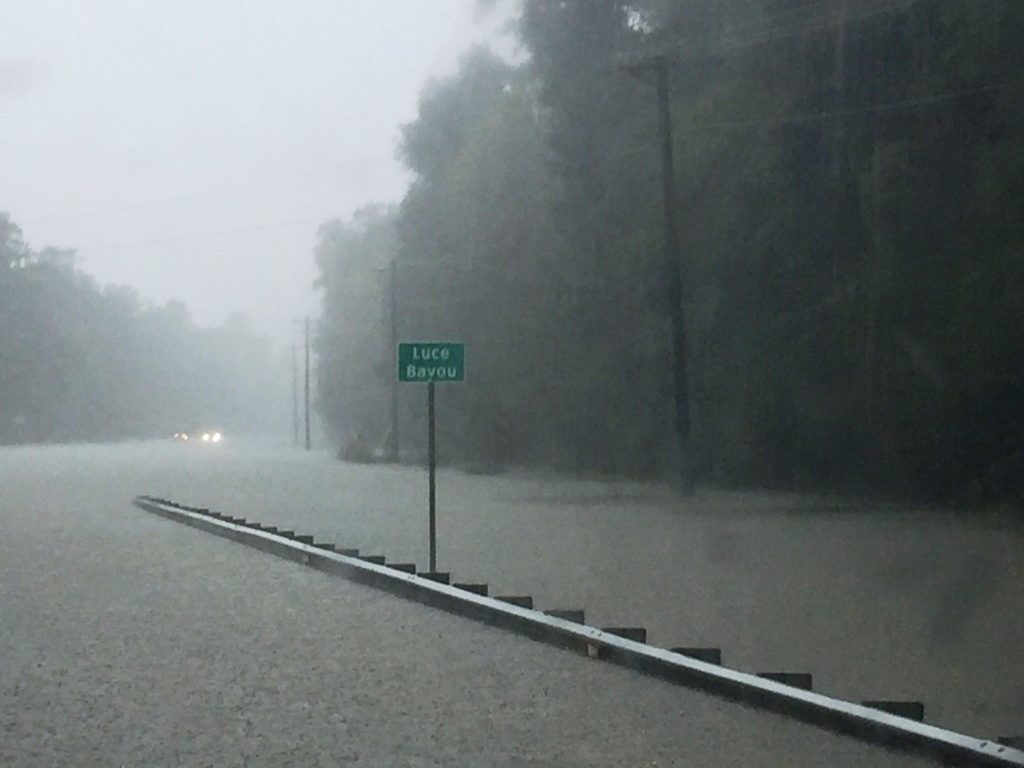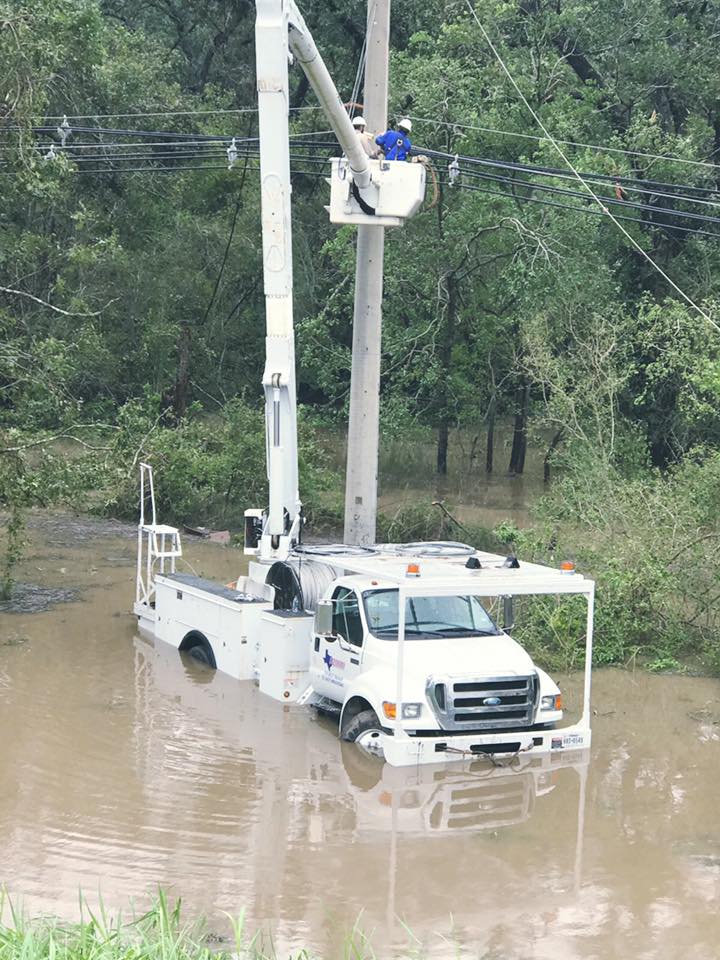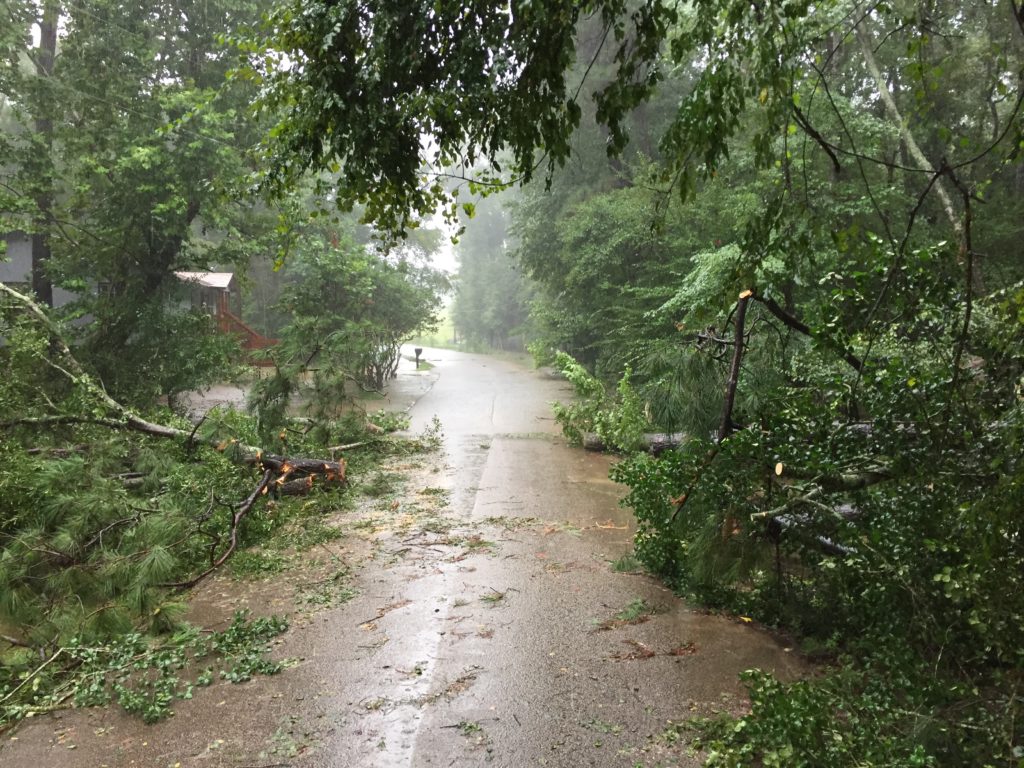
Electric cooperative line crews from across the state converged on troubled south Texas, toiling in pelting rain and thunderstorms left by Hurricane Harvey as they worked to bring back power to thousands of members who have been in the dark for four days.
While co-ops reported substantial progress in reducing outages from an overall total of 125,000, they face days or weeks of challenges in getting to spots washed out by historic flooding.
“Crews will be coming from as far away as North Plains Electric Cooperative at the top of the Texas Panhandle,” said Martin Bevins, vice president of communications and member services for Texas Electric Cooperatives. The statewide association has been coordinating statewide mutual aid, and requests for assistance from the hardest hit co-ops picked up on Aug. 28.
Bevins added that some co-ops already have received help from sister co-ops in areas that suffered less damage.
Listen: Keith Stapleton, CCO, Sam Houston Electric Cooperative, discusses Hurricane Harvey and the efforts to restore power.
Harvey dumped more than 25 inches of rain in more than 15 counties surrounding the Houston metropolitan area. Squall lines associated with the weather system continued to dump torrential rains over some co-op-served communities. Thousands have been rescued amid rising waters.
Hardest hit was Victoria Electric Cooperative, where Harvey took down 22,000 members, most of the Victoria-based distribution system. As of late afternoon on Aug. 29, the co-op said it had 3,886 meters back online and had restored a key substation. The co-op had 217 linemen linemen working during daylight hours and an internal support staff of 52 working around the clock on restoration efforts.

“Victoria EC’s restoration efforts were hindered by a rising Guadalupe River which, on Monday morning, was flooding roads, limiting travel and adding uncertainty to the logistics of power restoration,” said Bevins.
“San Patricio Electric Cooperative, headquartered in Sinton suffered near-total outages on its 11,000-meter system,” said Bevins. “Nueces Electric Cooperative, based in Robstown, reported nearly 8,000 meters out immediately after landfall.”
Nueces EC, located west of the storm’s track where rain has been less of a problem, was able to restore power to virtually all of its affected members within 48 hours.
However, San Patricio EC said Aug. 29 that it was down to about 1,500 outages. But getting its full system back could take up to two weeks, said Brittany Williams, the co-op’s public relations coordinator. About 250 people were in the field between co-op crews and contractors.
“We’ve asked for 20 to 25 co-op people for mutual aid,” said Williams. “We’ve got crews coming from Nueces EC, Medina Electric Cooperative in Hondo, Corinth-based CoServ, and North Plains Electric Cooperative in Perryton.”
Guadalupe Valley Electric Cooperative, based in Gonzales, had about 330 members out as of afternoon on Aug. 29, down from 15,000 as of Aug.26.

But heavy rains and flooding stalled restoration in other storm-affected areas.
“We’ve had hurricanes, they blow through in a few hours, this is much worse,” said Keith Stapleton, chief communications officer of Sam Houston Electric Cooperative. “Harvey has camped on top of the area and is expected to make a second landfall on Wednesday.”
The Livingston-based co-op serves more than 70,000 meters in the Piney Woods of east Texas. It reported up to 21,000 meters out at times because of Harvey, but the number has fluctuated up and down as tall trees, held up by rain sodden root systems, have toppled onto power lines.
“Trees are falling almost like dominoes,” said Stapleton, adding that less than 1,800 meters were out of service late Aug. 29. “Trees are falling, and when they fall, they take down power lines.”
Bastrop-based Bluebonnet Electric was down to a handful of outages late Aug. 28. “Bluebonnet had dozens of crews working 12-hour shifts and even resorted to using an air boat to restore power,” said Bevins, citing reports to the statewide association.
In Ganado, Jackson Electric Cooperative said it restored power Aug. 28 to approximately 1,900 homes with the help of 30 linemen from other co-ops and contractors.
“We are still days away from total restoration, but we are optimistic,” the co-op reported.
While Harvey, now a tropical storm, is not expected to redevelop hurricane strength over the Gulf of Mexico, meteorologists have warned that it will pick up even more moisture before it makes a second landfall near Beaumont, Texas, late this week. Highest sustained winds are expected to be around 45 mph.
“We’re expecting winds of only 25 to 30 mph in our service territory, but the ground is already soaked, and trees will uproot fairly easily,” said Stapleton. “That’s going to take down even more trees, so will continue having problems.”
Crews are also dealing with road closures in many areas, making it difficult to complete damage assessments or reach some areas to begin repairs.
Two major 345-kilovolt transmission lines serving the Gulf Coast area are still out of service, along with other high-voltage transmission lines, according to the Electric Reliability Council of Texas, which operates most of the state’s grid. About 6,700 megawatts of generation capacity, including a very small percentage of renewables, was off line, ERCOT said Aug. 28.
Derrill Holly is a staff writer at NRECA.
Editor’s note: This post is continually updated to reflect changing outage reports.